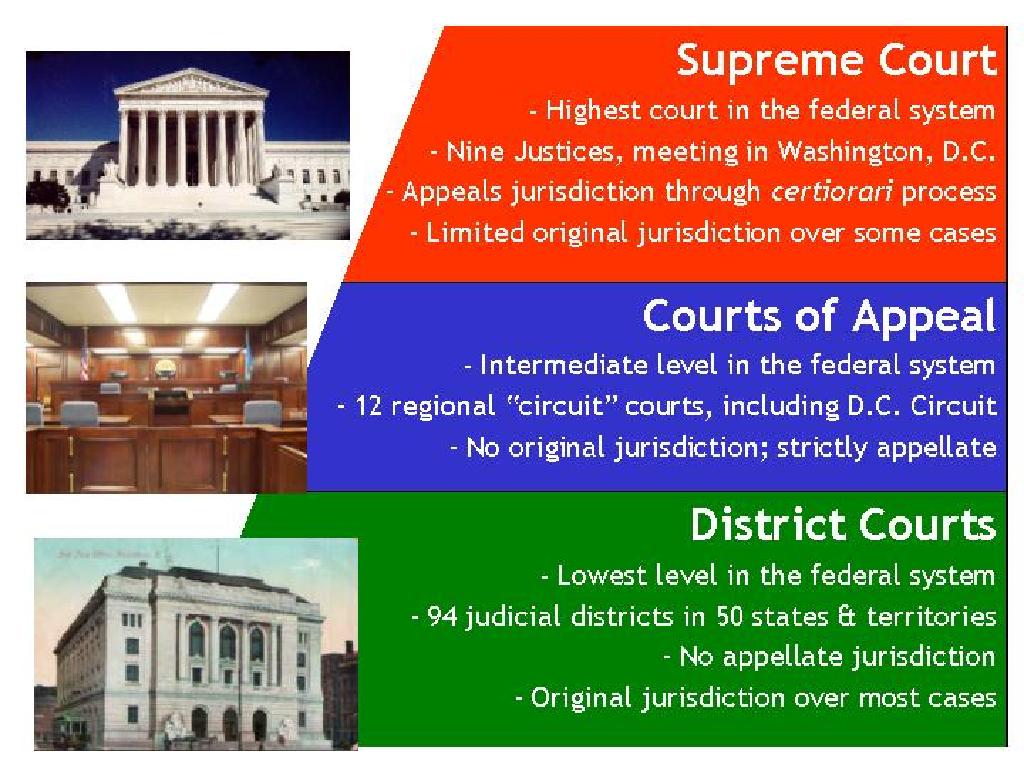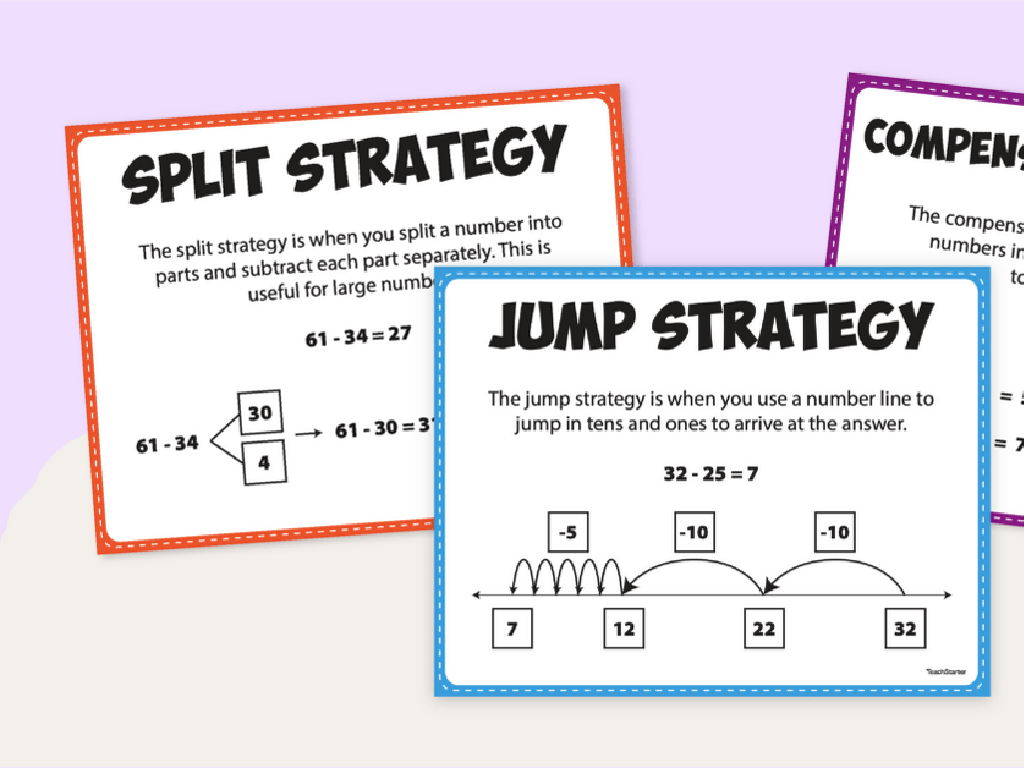Use Compensation To Add: Up To Three Digits
Subject: Math
Grade: Third grade
Topic: Addition: Three Digits
Please LOG IN to download the presentation. Access is available to registered users only.
View More Content
Welcome to Addition: Mastering Compensation
– Discover the compensation trick
– A method to adjust numbers to make them easier to add
– Compensation simplifies addition
– Round a number up and adjust the other to keep the sum same
– Practice makes perfect
– Aim to be addition experts
|
Today’s lesson introduces the concept of compensation in addition, which is a strategy to make mental math easier by rounding numbers to the nearest ten, hundred, etc., and then adjusting the sum accordingly. For example, to add 398 + 47, we can round 398 to 400, add it to 47 to get 447, and then subtract 2 to compensate for the rounding. This method helps students to add numbers quickly and efficiently in their heads. Encourage the students to practice this technique with various numbers to become confident in using compensation for addition. By the end of the lesson, students should feel more comfortable with adding larger numbers and understand how compensation can be a useful tool in their math toolbox.
Understanding Compensation in Addition
– What is compensation?
– Adjusting numbers to simplify addition.
– Making numbers friendlier
– Like turning 398 into 400 for easier calculation!
– Rounding numbers for ease
– Round up or down to nearest 10 or 100.
– Quick addition with compensation
|
Compensation is a useful strategy for adding numbers more easily by adjusting them to a ‘friendlier’ number, typically a multiple of 10 or 100. For example, if a student is adding 398 + 307, they might round 398 up to 400 and 307 down to 300 for quick mental addition, getting 700. Then they compensate for the rounding by subtracting the extra 5 they added. This slide should introduce the concept and show how rounding numbers can simplify the process of addition. Encourage students to practice this technique with various numbers to become comfortable with the concept of compensation.
Why Use Compensation in Addition?
– Simplifies addition of large numbers
– Instead of 276 + 399, think 280 + 400 = 680
– Enhances mental math skills
– Add numbers in your head without writing them down
– Useful for quick estimations
– Estimate costs like shopping totals quickly
– Practical for everyday calculations
|
Compensation is a useful strategy for adding numbers more efficiently by rounding them to the nearest ten or hundred. This technique simplifies the addition process, especially with three-digit numbers, and enhances a student’s ability to perform mental math. It’s also a practical skill for making quick estimations in various real-life situations, such as calculating expenses while shopping. Encourage students to practice this method with different numbers and to share how this strategy can be applied outside of the classroom.
Using Compensation to Add Large Numbers
– Understand compensation
– Example: Adding 256 + 398
– Round 256 to 260 and 398 to 400 for simpler addition
– Easier addition with rounding
– Adding rounded numbers: 260 + 400 = 660
– Adjusting the final sum
– Subtract the extra added from rounding to find the actual sum
|
This slide introduces the concept of compensation in addition, which helps simplify the process of adding large numbers. Start by explaining that compensation means adjusting numbers to make them easier to work with. Use the example provided to show how rounding numbers to the nearest ten can simplify addition. After demonstrating the easier addition with rounded numbers, emphasize the importance of adjusting the final sum to account for the initial rounding. This will ensure students understand the need to compensate for the extra amount added during rounding. Encourage students to practice this method with various numbers to become comfortable with the concept.
Balancing Our Compensation
– Compensate by rounding numbers
– Example: 256 + 398 becomes 260 + 400
– We rounded 256 to 260 and 398 to 400 for easy adding
– Subtract the extra we added
– We added 6 extra (4 from 256 and 2 from 398)
– Find the actual sum: 654
– After subtracting the extra 6, we get the real total
|
This slide teaches students the concept of compensation in addition. Compensation is a strategy where we make numbers easier to add by rounding them, then adjust the sum by subtracting the amount we added. For example, when adding 256 and 398, we can round them to 260 and 400 for easier addition, getting 660. Since we added an extra 4 for 256 and an extra 2 for 398, we added 6 too much. To balance our compensation, we subtract the extra 6 from 660, resulting in the actual sum of 654. This method helps simplify addition problems with large numbers and enhances mental math skills.
Let’s Practice Compensation in Addition!
– Try adding 143 + 289 with compensation
– Round 143 to 140 and 289 to 290
– Add the rounded numbers
– 140 + 290 equals 430
– Adjust for the compensation
– Add back the 3 we subtracted from 143 and the 1 we added to 289
|
This slide is designed to teach students the concept of compensation in addition. Compensation is a strategy where numbers are rounded to make addition easier, then adjusted to get the final answer. Start by rounding 143 down to 140 (subtracting 3) and 289 up to 290 (adding 1). Then add the rounded numbers to get 430. Finally, adjust for the compensation by adding back the 3 subtracted from 143 and the 1 added to 289, resulting in 430 + 3 + 1 = 434. Encourage students to use this method with other numbers and to explain their thinking process. This exercise helps students to simplify problems and to understand the importance of place value in addition.
Class Activity: Compensation Challenge
– Pair up for a math adventure
– Find numbers to add using compensation
– Look for numbers that are close to a ‘friendly’ number, like 30, 40, or 50
– Show your work on whiteboards
– Write down each step as you adjust the numbers to make adding easier
– Share your discoveries with everyone
|
This activity is designed to help students practice the concept of compensation in addition. Compensation is a strategy where you adjust numbers to make them easier to work with. For example, if you’re adding 29 + 15, you can adjust 29 to 30 by adding 1, which you then subtract from 15, making the new problem 30 + 14. This is easier to add mentally. Have the students work in pairs to encourage collaboration. They should use whiteboards to visually demonstrate their thought process, making it easier for them to share their strategies with the class. As a teacher, walk around to assist and ensure understanding. Prepare to highlight different strategies used by students during the sharing portion of the activity.
Conclusion & Review: Mastering Compensation
– Compensation simplifies addition
– Make tough sums easier by rounding numbers, then adjust
– Balance numbers post-compensation
– After compensating, ensure the final sum is correct
– Practice to perfect your skills
– Try more examples to become confident
– Review and apply at home
|
As we wrap up, remember that compensation is a strategy to make adding easier, especially with three-digit numbers. It involves adjusting numbers to make them round, then balancing the equation after. Encourage students to practice this method by providing additional worksheets and examples they can work on at home. Reinforce the concept by revisiting it in future lessons and integrating it into various math problems. The goal is for students to become comfortable with compensation and to use it as a tool to check their work for accuracy.






